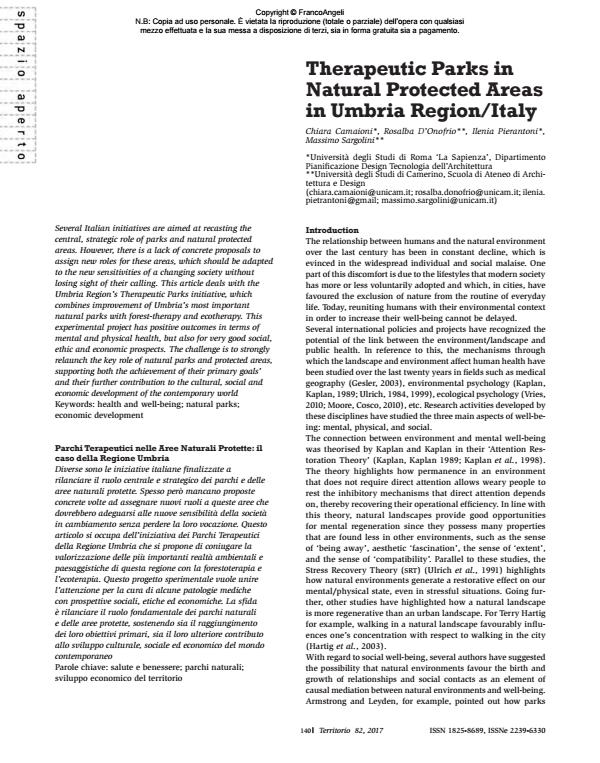Therapeutic Parks in Natural Protected Areas in Umbria Region/Italy
Titolo Rivista TERRITORIO
Autori/Curatori Chiara Camaioni, Rosalba D’Onofrio, Ilenia Pierantoni, Massimo Sargolini
Anno di pubblicazione 2017 Fascicolo 2017/82
Lingua Inglese Numero pagine 9 P. 140-148 Dimensione file 430 KB
DOI 10.3280/TR2017-082024
Il DOI è il codice a barre della proprietà intellettuale: per saperne di più
clicca qui
Qui sotto puoi vedere in anteprima la prima pagina di questo articolo.
Se questo articolo ti interessa, lo puoi acquistare (e scaricare in formato pdf) seguendo le facili indicazioni per acquistare il download credit. Acquista Download Credits per scaricare questo Articolo in formato PDF

FrancoAngeli è membro della Publishers International Linking Association, Inc (PILA)associazione indipendente e non profit per facilitare (attraverso i servizi tecnologici implementati da CrossRef.org) l’accesso degli studiosi ai contenuti digitali nelle pubblicazioni professionali e scientifiche
Several Italian initiatives are aimed at recasting the central, strategic role of parks and natural protected areas. However, there is a lack of concrete proposals to assign new roles for these areas, which should be adapted to the new sensitivities of a changing society without losing sight of their calling. This article deals with the Umbria Region’s Therapeutic Parks initiative, which combines improvement of Umbria’s most important natural parks with forest-therapy and ecotherapy. This experimental project has positive outcomes in terms of mental and physical health, but also for very good social, ethic and economic prospects. The challenge is to strongly relaunch the key role of natural parks and protected areas, supporting both the achievement of their primary goals’ and their further contribution to the cultural, social and economic development of the contemporary world
Diverse sono le iniziative italiane finalizzate a rilanciare il ruolo centrale e strategico dei parchi e delle aree naturali protette. Spesso però mancano proposte concrete volte ad assegnare nuovi ruoli a queste aree che dovrebbero adeguarsi alle nuove sensibilità della società in cambiamento senza perdere la loro vocazione. Questo articolo si occupa dell’iniziativa dei Parchi Terapeutici della Regione Umbria che si propone di coniugare la valorizzazione delle più importanti realtà ambientali e paesaggistiche di questa regione con la forestoterapia e l’ecoterapia. Questo progetto sperimentale vuole unire l’attenzione per la cura di alcune patologie mediche con prospettive sociali, etiche ed economiche. La sfida è rilanciare il ruolo fondamentale dei parchi naturali e delle aree protette, sostenendo sia il raggiungimento dei loro obiettivi primari, sia il loro ulteriore contributo allo sviluppo culturale, sociale ed economico del mondo contemporaneo
Parole chiave:Salute e benessere; parchi naturali; sviluppo economico del territorio
- Relational values about nature in protected area research Alta De Vos, Carlos Bezerra Joana, Roux Dirk, in Current Opinion in Environmental Sustainability /2018 pp.89
DOI: 10.1016/j.cosust.2018.10.018
Chiara Camaioni, Rosalba D’Onofrio, Ilenia Pierantoni, Massimo Sargolini, Therapeutic Parks in Natural Protected Areas in Umbria Region/Italy in "TERRITORIO" 82/2017, pp 140-148, DOI: 10.3280/TR2017-082024